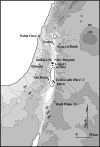Evidence for food storage and predomestication granaries 11,000 years ago in the Jordan Valley
- PMID: 19549877
- PMCID: PMC2700141
- DOI: 10.1073/pnas.0812764106
Evidence for food storage and predomestication granaries 11,000 years ago in the Jordan Valley
Abstract
Food storage is a vital component in the economic and social package that comprises the Neolithic, contributing to plant domestication, increasingly sedentary lifestyles, and new social organizations. Recent excavations at Dhra' near the Dead Sea in Jordan provide strong evidence for sophisticated, purpose-built granaries in a predomestication context approximately 11,300-11,175 cal B.P., which support recent arguments for the deliberate cultivation of wild cereals at this time. Designed with suspended floors for air circulation and protection from rodents, they are located between residential structures that contain plant-processing instillations. The granaries represent a critical evolutionary shift in the relationship between people and plant foods, which precedes the emergence of domestication and large-scale sedentary communities by at least 1,000 years.
Conflict of interest statement
The authors declare no conflict of interest.
Figures





References
-
- Bar-Yosef O. The Natufian culture in the Levant, threshold to the origins of agriculture. Evol Anthropol. 1998;6:159–177.
-
- Boyd B. On “sedentism” in the later Epipaleolithic (Natufian) Levant. World Archaeol. 2006;38:164–178.
-
- Goring-Morris N, Belfer-Cohen A. The articulation of culture process and Late Quaternary environmental change in CisJordan. Paléorient. 1998;23:71–93.
-
- Perrott J, Ladiray D. Les Hommes de Mallaha (Eynan), Israel. Paris: Association Paléorient; 1988. (in French)
-
- Finlayson B, et al. Dhra′ excavation project, 2002 interim report. Levant. 2003;25:1–38.
Publication types
MeSH terms
LinkOut - more resources
Full Text Sources

